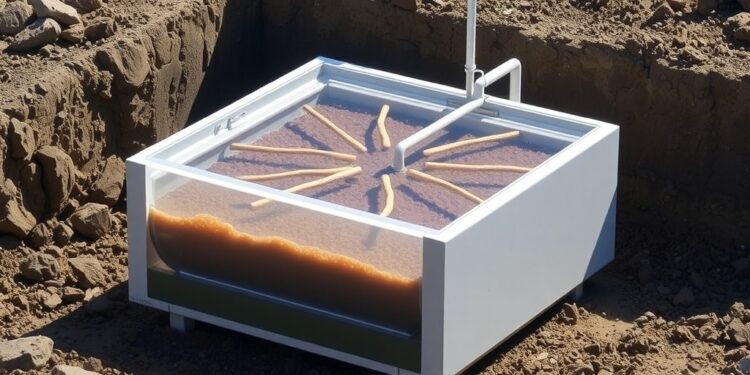
Researchers at the University of Alcalá have made significant strides in wastewater treatment technology, developing an electroactive biofilter (BioeF) that not only tackles traditional pollutants but also emerging contaminants (ECs) such as pharmaceuticals and herbicides. This advancement is poised to revolutionize our approach to environmental remediation through innovative scientific methodologies, incorporating both biological and electrochemical principles. The BioeF system exemplifies a transformative approach to bioengineering and pollution control, showcasing how interdisciplinary research can lead to real-world applications in water quality management.
The conventional methods of treating wastewater often fall short in effectively removing ECs, which are increasingly recognized for their detrimental effects on aquatic ecosystems and human health. In contrast, the BioeF operates on the cutting edge of technology, utilizing microbial electrochemical systems that enable more effective biodegradation processes. This unique system functions by creating a microbial consortium that breaks down complex organic molecules into less harmful compounds while also facilitating electron transfer processes that enhance the rate of degradation.
In a recent experimental study, the researchers demonstrated that the BioeF could remove up to 80% of pharmaceutical contaminants and between 50% to 75% of herbicides from wastewater. These figures starkly contrast with those of traditional gravel-based filters, which typically achieve around 50% removal efficiency for pharmaceuticals and almost negligible results for herbicides. Such a leap in performance underscores the urgent need for innovative solutions to address the inadequacies of existing wastewater treatments, particularly as regulations around water quality become increasingly stringent.
One of the most compelling aspects of the BioeF technology is its ability to modify the chirality of emerging contaminants, essentially altering the spatial arrangement of atoms in these molecules. This characteristic introduces a novel dimension to wastewater treatment, as the chiral nature of many pharmaceuticals affects both their toxicity and biodegradability. By manipulating these stereochemical properties, the BioeF not only diminishes the ecological risks associated with these contaminants but also opens avenues for tailoring treatment processes to target specific pollutants more effectively.
The findings from this innovative research have broader implications for sustainability in wastewater management. Conventional treatment methods often rely on chemical additives or extensive aeration processes that require substantial energy input, thereby increasing operational costs and environmental footprints. In contrast, the BioeF employs microbial electrochemical mechanisms that function optimally under anaerobic conditions, drastically reducing the need for artificial oxygenation. This efficiency not only suggests lower operational costs but also aligns with global sustainability goals aimed at minimizing ecological impact.
Supporting this groundbreaking research is Dr. Karina Boltes, the lead researcher, who underlines the significance of these findings in combating EC pollution, which has emerged as a critical global issue. The BioeF stands out as a scalable and adaptable solution, making it a strong candidate for implementation in various settings, from small-scale municipal treatment plants to larger industrial wastewater facilities. The technology’s versatility could facilitate its integration into existing infrastructure, thereby enhancing the efficacy of current systems without necessitating complete overhauls.
Looking ahead, the research team is excited about exploring the full potential of the BioeF system. Future studies are planned to optimize its design and operational parameters, with an emphasis on expanding the range of contaminants it can address. Additionally, further investigation into the enantioselective mechanisms responsible for chirality modification in ECs may unveil new opportunities for tailoring wastewater treatment practices. This avenue of research holds promise not only for enhancing removal efficiencies but also for developing more targeted approaches to manage specific pollutants based on their toxicological profiles.
The support received from the Spanish Ministry of Science highlights the essential role of governmental and institutional backing in driving forward critical research initiatives. The commitment to investigating innovative solutions for environmental challenges reflects a broader recognition of the importance of clean water access. As the global population continues to increase, the demand for efficient wastewater treatment systems will only grow, necessitating rapid advancements in technology and methodology.
The BioeF’s success could propel further investment and interest in microbial electrochemical technologies, encouraging collaboration between academia and industry. Such partnerships are vital for translating laboratory innovations into practical applications that can serve communities worldwide. The potential for biofilters capable of efficient contaminant removal and ecosystem protection presents an enticing premise that could redefine standard practices in water management.
In essence, the combination of microbial electrochemical systems and advanced biodegradation strategies within the BioeF presents a pioneering solution to an age-old environmental problem. Its ability to address both the quantity and quality of contaminants in wastewater poses a critical resource for combating pollution while promoting sustainability. Through continued research and innovation, the BioeF exemplifies how science can provide solutions to complex ecological challenges, safeguarding water resources for future generations.
The repercussions of this research extend far beyond technical advancements; they tap into fundamental discussions about our relationship with the environment. The rising concern surrounding emerging contaminants poses a series of ethical considerations about responsibility, stewardship, and the role of science in resolving ecological crises. By implementing systems that improve wastewater treatment efficiency, researchers and practitioners can demonstrate a commitment to environmental health and community welfare.
In conclusion, the electroactive biofilter developed by the University of Alcalá not only signifies a technological breakthrough but also embodies the spirit of collaborative research aimed at fostering innovation in environmental science. As communities worldwide grapple with increasing water quality challenges, such advancements offer a ray of hope. The drive to develop practical, effective solutions for wastewater treatment showcases the profound impact of scientific inquiry on society and the environment.
Subject of Research:
Article Title: Enhanced removal of chiral emerging contaminants by an electroactive biofilter
News Publication Date: 30-Oct-2024
Web References: DOI
References:
Image Credits:
Keywords





